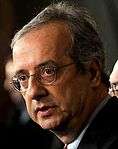Rome municipal election, 2001
| | ||||||||||||||||||||||||||||
| ||||||||||||||||||||||||||||
| ||||||||||||||||||||||||||||
| ||||||||||||||||||||||||||||
Municipal elections were held in Rome on 13 and 27 May 2001, at the same time as Italian general elections. The outgoing Mayor of Rome, Francesco Rutelli (Greens), was candidate in the general elections, so he resigned in January. The center-right candidate Antonio Tajani, was faced by the center-left candidate Walter Veltroni who was chosen to head his coalition.
Control of the 19 municipi of the Italian capital was also to be decided in the elections. The municipi were born on 19 January 2001 and replaced the old 12 circoscrizioni, born in 1966. 59 councillors were due to be elected in the City Council.
As a result of the election, Walter Veltroni was elected on the 2nd round. The center-left controls 36 seats against for the center-right.
Background
Following the end of the XIV Italian Legislature, Rutelli led the center-left coalition into the May 2001 general election and resigned as Mayor of Rome on 8 January 2001, two days after the end of the Great Jubilee on which he had spent all his second term, to concentrate on the campaign.
Mayoral election
The center-right coalition was led by Antonio Tajani (Forza Italia), who was heavily defeatd by Rutelli in 1997; Tajani rejected a formal alliance with the far-right party and preferred a liberal-conservative coalition like the one which supported Silvio Berlusconi in the general election.
The center-left coalition was led by the former Deputy Prime Minister Walter Veltroni, who has been Minister of Culpture during the first Prodi Cabinet (1996–1998).
Voting System
The voting system is used for all mayoral elections in Italy, in the city with a population higher than 15,000 nhabintants. Under this system voters express a direct choice for the mayor or an indirect choice voting for the party of the candidate's coalition. If no candidate receives 50% of votes, the top two candidates go to a second round after two weeks. This gives a result whereby the winning candidate may be able to claim majority support, although it is not guaranteed.
For municipi the voting system is the same, not referred to the mayor but to the president of the municipio.
The election of the City Council is based on a direct choice for the candidate with a preference vote: the candidate with the majority of the preferences is elected. The number of the seats for each party is determined proportionally.
Results
| Rome Mayoral Election Results 2001 | ||||||||
|---|---|---|---|---|---|---|---|---|
| Name | Party | 1st Round (May 13) | % | 2nd Round (May 27) | % | |||
| Walter Veltroni | Democrats of the Left (DS) | 800,660 | 48.4 | 871,930 | 52.2 | |||
| Antonio Tajani | Forza Italia (FI) | 747,169 | 45.1 | 799,363 | 47.8 | |||
| Rome Council Election 2001 - Parties | ||||||||
|---|---|---|---|---|---|---|---|---|
| Coalition | votes | % | seats | Party | votes | % | seats | |
| The Olive Tree (Veltroni) | 614,002 | 45.49 | 36 | Democrats of the Left Democracy is Freedom - The Daisy Communist Refoundation Party Greens Party of Italian Communists Italian Democratic Socialists Others (1) | 238,092 111,315 61,728 31,698 15,462 9,244 146,463 | 17.64 8.25 4.57 2.35 1.15 0.68 10.85 | 15 7 3 2 - - 9 | |
| House of Freedoms (Tajani) | 640,933 | 47.49 | 23 | National Alliance Forza Italia Christian Democratic Centre New Italian Socialist Party Italian Republican Party Others (5) | 283,922 259,514 41,148 8,268 3,136 44,945 | 21.04 19.23 3.05 0.61 0.23 3.34 | 11 10 1 - - 1 | |

.jpg)